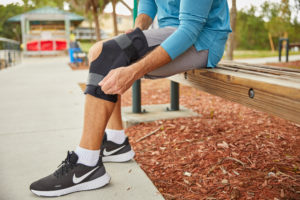Sports injuries occur during exercise or training. There are many different sports injuries, including sprains, strains, muscle injuries, and dislocations.
Treatment for sports injuries depends on the location and the severity of the injury. Initial treatment often includes resting, icing the affected area, warming sore muscles, and going to a doctor. After consulting with a medical professional, you might need to wear a brace to temporarily immobilize the injured area.
Knee Braces
There are several types of knee braces to consider. The type of brace you choose depends on many factors such as preference, injury severity, and the recommendation from your doctor. These include:
- Hinged: A hinged brace provides plenty of support for proper alignment and healing. Hinged knee braces limit the amount of movement possible.
- Compression Sleeve: This type of brace is excellent for chronic pain from injuries or arthritis. The brace decreases pain during sports and offers support. They are easy to put on and low profile.
- Band Strap: Aband strap sits right under the patellar bone of the knee to decrease pain and provide stability. They are ideal for runner’s knee or jumper’s knee.
- Wrap-Arounds: The wrap-around braces are easy to customize and provide support throughout daily activity and sports.
- Custom/Orthopedic Braces: You can find orthopedic braces and supports customized for your specific needs. You will need to take measurements of the knee so that the brace can be fitted to you.

Elbow Braces
As with knee brace, elbow brace types include hinged, custom, compression, and wrap. You can also find a custom orthopedic elbow brace.
Ankle Braces
You will also find several different types of ankle braces, including:
- Lace-Up: These are mostly fabric braces that give your ankle a little bit of support. Be aware that the lace-up braces can limit the range of motion.
- Hinged: These have a rigid shell for support during recovery and prevention of further injury, but they can be a bit bulky.
- Hinge-Cuff: This type of brace has good support and rotational stability. Many athletes use this type of brace while recovering from an injury.
If you need an ankle brace, you should also consider footwear options. You ideally want a lightweight shoe that’s roomy for the brace. A shoe with a small heel for support is better than a flat shoe.
Wrist Braces
Some wrist braces are softer, while others have a harder cast for extra support. You can find wrist braces with or without a thumb splint.
Back Braces
You can find back braces in several different sizes and styles. Back braces can be soft, semi-rigid, or rigid, depending on how much support you need. Your doctor can recommend which type of back brace is best for your injury.
Elastic Bandages
Elastic bandages are self-adhesive, wide bandages that support an injury and add compression to help reduce swelling. The bandages provide gentle pressure and a little bit of support for strains and sprains; they essentially function a little bit like a soft brace.
What Type of Brace Do I Need?
The type of brace you need will depend on the location and severity of the injury. We recommend that you see a doctor for any serious injury or if you are not sure how to treat it.
Also, you should always follow the guidance of your doctor, or another medical professional on your healthcare team, about what brace to choose.
If you’re looking for a brace to help heal a sports injury, shop Simply Medical today.

